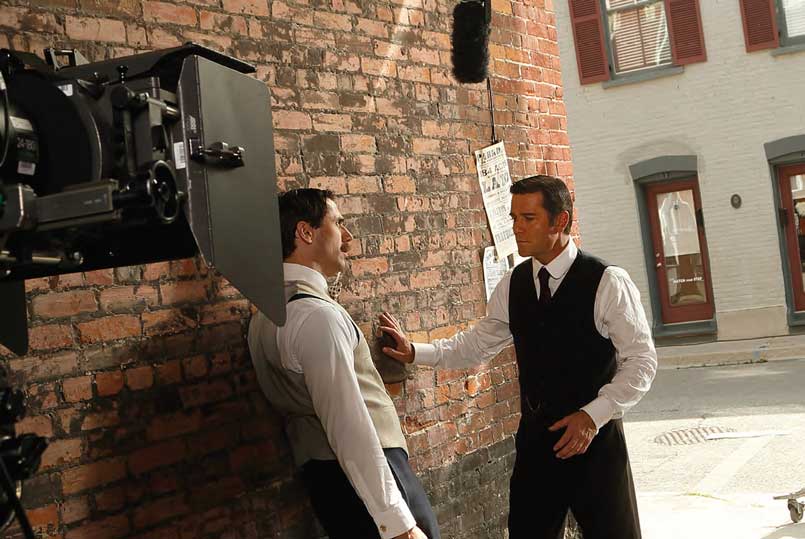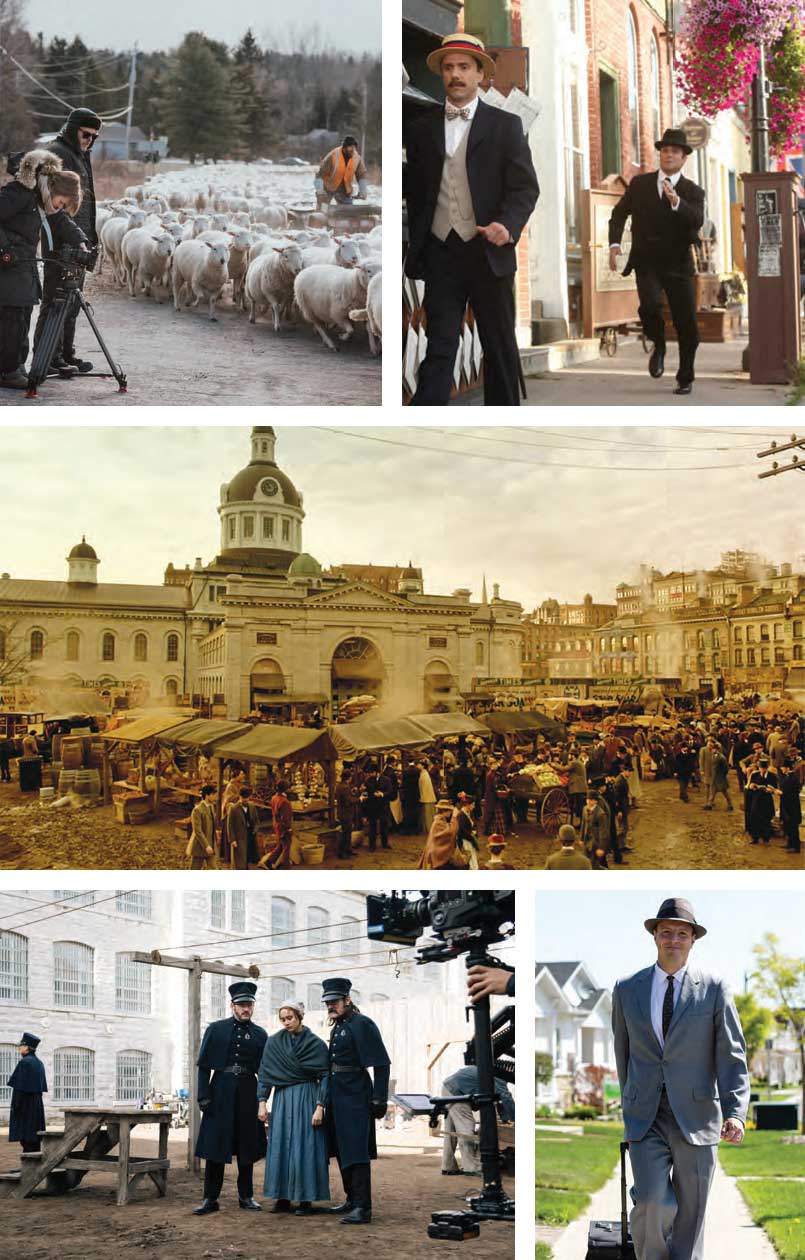
Cyrus Lane (Newsome) and Yannick Bisson (Murdoch) prepare to film a scene on location in Port Hope; photograph by Stephen Scott

left to right and top to bottom: Director Ryan Noth and cinematographer Tess Girard of Fifth Town Films filming Drifting Snow in PEC; Murdoch (Yannick Bisson) chasing Roger Newsome (Cyrus Lane, left) in Port Hope; the set of Crimson Peak at Springer Market Square in Kingston; the set of Alias Grace in Kingston; The Offer produced by Chad Maker and Hugh Dillon in Cobourg
It’s not your imagination. Movie crews have discovered our corner of the countryside. COVID may have dealt the film industry a blow, but it’ll soon be back in action.
My wife is a Murdoch Mysteries Super Fan. I swear she has seen every episode at least twice, even more as we sit out the COVID lockdown. If you don’t know – and every Canuck worth his or her maple leaf should know – Murdoch is a CBC-TV series, a rare genuinely Canadian hit that has been running since 2008. Set in the early years of the 20th century, it follows dreamy detective William Murdoch as he uses his uncanny intuition and innovative technology to solve murders in Edwardian Toronto. It’s a clever whodunit with plenty of plot twists, but what my wife likes most is how it deals with modern subject matter and social issues in a turn-of-the-century context.
Me, I like Murdoch because I’m a history buff, especially when it comes to vintage architecture. More times than I can count, I’ve seen local landmarks used for location shooting and, much to my wife’s chagrin, I’m prone to pointing them out while we’re watching the plot unfold.
“That was shot on the beach in Cobourg!” I exclaim as we watch Murdoch’s wife go for a stroll along the “Toronto” waterfront. “I recognize the pergola on the boardwalk.” As a group of people pushes past her, one of them falls dead, a victim of foul play. The action heats up as the cops pursue the culprit across a lawn, but I’m more smitten with the location. “They’re running through Victoria Park toward King Street,” I tell my wife.
My wife rolls her eyes. “Do you HAVE to ruin every episode for me?”
Thinking the better of it, I refrain from telling her that the building they use as the Toronto railway station is actually Victoria Hall on King Street. I recognize the arched stonework.
LIGHTS, CAMERA, ACTION
Cobourg is not the only local town to have hosted a movie shoot in recent years. In fact, as Toronto becomes more and more important as a hub for the film industry, the small towns within a day’s drive are reaping the benefits, too. Indeed, it’s pretty much a sure thing that you’ve recently seen something – a movie, a TV show or even a commercial – that was shot in Cobourg, Trenton, the County or some other locale in Watershed country, even if the location wasn’t easily recognizable. But the place that has benefited most – hands down – is Port Hope, which has a couple of aces up its sleeve. “Not only are we closest to the studios in Toronto, we also have the best preserved main street in Ontario,” says Kevin Narraway who, among other duties as the town’s marketing and tourism manger, fields inquiries from movie producers. “Any project that requires that quintessential small-town feel need look no further.”
It was precisely this quality that enabled Port Hope to score a huge coup in 2016, when it was chosen for much of the principal photography for It, a film based on the Stephen King novel, which was destined to become the highest grossing horror movie in a generation.
Set in 1980s Derry, a fictional New England town, the movie follows a gang of pre-teens who are haunted by a malevolent circus clown – it’s a kind of Stand by Me with an evil monster. With much of the shoot already committed to a studio in Toronto, perhaps it was only natural to turn to Port Hope for some authentic small-town backgrounds and scenic locations. “It helped,” adds Kevin, “that Mike Bruce, locations manager for the filmmakers, grew up in Campbellford.”
In July, a crew of about 400 people – count ’em, 400! – descended into town. Not just the cast and the director, but carpenters and camera operators, too. Gaffers and gofers; key grips and dolly grips; dressers and prop masters; vintage car-owners and vintage costumers; makeup artists and hairdressers. “It was like the circus had come to town,” Kevin quips. When the cameras started to roll, Port Hope town hall had been transformed into the Derry library. Key scenes were shot in the bandshell in a downtown park. Several Walton Street shopfronts were re-signed to suit the script. And front and centre, there’s no mistaking the Capitol Theatre. Perhaps what is most remarkable is that the shoot was completed in less than two weeks and that the cast and crew disappeared almost as quickly as they had arrived.
And then, It was such a smash that they returned again in 2018 to shoot the sequel.
Bragging rights only go so far, and to be honest, municipalities don’t charge enough in permit fees – in the neighbourhood of $1,000 a day – to make a movie shoot worth their while. Nevertheless, there is a very sound financial reason why towns like Port Hope fall over themselves to attract film crews. “The economic spin-off is huge,” says Kevin, noting that while in town, a movie crew eats at local restaurants, sources props at local stores, buys building materials at the local lumber yard, rents local office space and sleeps over at local hotels and B&Bs. “Add it all up and It alone injected about $1.8 million into our economy.” What’s more, Kevin says with a hint of pride, “That’s without the town spending a dime on new infrastructure.”
FOCUSING ON THE FUTURE
As economic stimulus goes, this is pretty easy money, but these days, there are a lot of other towns eager for a piece of the pie. “Toronto is such a major production centre that any smart town in or near the GTA would be wise to set up a film office and pick up some of the overflow,” says Albert Botha, a veteran line producer and filmmaker who lives in Alnwick/Haldimand Township (and is Watershed’s art director’s other half!) “In 2019,” he says, quoting industry figures, “343 productions were filmed in Ontario, supporting 44,540 jobs. It was a record year that generated some $2.16 billion to the economy, an increase of 15 percent over 2018.” No doubt about it – that’s good economic news, especially at a time when many traditional industries are in the doldrums.
“If just a fraction of that can be siphoned our way here in eastern Ontario, it’s as good for the local economy as attracting a new factory,” advises Albert, adding, “But it won’t happen by accident: any locale that wants in on the action has to make a plan.” With this in mind, Albert and a committee of other filmmakers and like-minded volunteers recently petitioned the provincial government to kick-start a $25 million fund – the South-Eastern Ontario Production Accelerator Fund or SEOPAF – whose goal is to further attract film companies to our area. Modelled after a similar effort in northern Ontario, Albert envisions it as a kind of one-stop shopping for producers looking for the best place to shoot their projects. Part of its mandate is to help co-ordinate location shooting and suggest venues that could serve as studio or office space, but most of all, SEOPAF hopes to provide subsidies to worthy productions that are shot here. If it sounds like a lot of money, “Remember, every dollar invested in film generates another $5 to the economy,” says Albert. “Besides, Toronto’s film industry is working almost at capacity, so it’s a no-brainer to try to spread the wealth to a region like ours.”
Toronto’s rise as a player in the film industry is the result of many factors, among them the exchange on the dollar, favourable tax incentives, NAFTA and TIFF. Moreover, large swaths of the city have a certain architectural ambiguity that doesn’t stand out from the crowd, which makes Toronto ideal for American directors keen on a look that could be Anytown, USA. Today, Toronto is the third largest centre for film and television production in North America (after L.A. and New York) and home to any number of film and animation studios, including the enormous 11-acre Pinewood Studios in the Docklands. It boasts no fewer than 11 sound stages and is large enough to attract the biggest of big-budget productions.
For some time now, it’s been full steam ahead for the film industry, but while 2019 was a banner year, 2020 was anything but. “We booked only two days of shooting last year,” remarks Kevin Narraway, explaining that over past years, the roster was full. In fact, Port Hope has had to limit the number of film shoots to 20 days a year, which is about as much as townspeople will tolerate lest the blocked streets, rerouted traffic and other inconveniences of location shooting turn into a nuisance. “We certainly didn’t have to worry about that in 2020.”
The culprit, of course, was the pandemic, which forced all of us to adjust to new and unforeseen circumstances. For the film industry, entire projects about to go into production were cancelled or shelved. Scriptwriters went back to the drawing board to reconfigure scenes so that they could be shot according to COVID protocols: fewer people in a conversation, fewer or no extras in the background, fewer fight scenes, and certainly no kissing. And worst of all, no… or less location shooting.
“Between 30 and 35 percent of a typical Murdoch episode is shot on location,” says Stephen Montgomery, who has been a producer on the show since 2011. Last year, thanks to pandemic precautions, the figure was down to the low 20s. “Location shooting has a much bigger footprint than the studio or our backlot,” he explains. “The crew is spread out more and the scenes are bigger in scope, involving more personnel.” Indeed, it has just been simpler – and safer – to film on a closed sound stage during the pandemic.
Stephen can’t wait till COVID blows over, and a day on location can once again be a treat for the cast and crew. “Location shooting lets us venture outside our normal routine,” he says. “It’s like having a field trip at school.” After 14 seasons, he and the rest of the Murdoch crew have it down to a science. On location, they are usually working on two episodes at once and every detail is worked out in advance. Before the cameras roll, each shot has been planned while a crew has already been on hand for several days, dressing the street to hide parking meters, mailboxes, electric signs, fire hydrants and anything else that would not be true to the show’s turn-of- the-century setting.
“When choosing a location, we specifically look for towns that have retained their heritage, which minimizes the amount of manipulation we have to do on site or in post-production,” confides Stephen. This alone explains why Murdoch keeps coming back to Port Hope and Cobourg, but truth to tell, they’d perhaps visit us more often if not for a specific proviso in Ontario’s tax incentives policy: “Financially, we are a tax-driven show and sometimes we need to select locations that are well outside the GTA – one-and-a-half to two hours away – to quality for an additional regional tax credit.”
While in town, a movie crew eats at local restaurants, sources props at local stores, buys building materials at the local lumber yard, rents local office space and sleeps over at local hotels and B&Bs.
No amount of preparation can guarantee that a location shoot will go off without a hitch. “Sometimes, a scene takes longer than anticipated and we risk losing daylight,” continues Stephen. “But the big wild card is weather. We just can’t re-create the sun.” Indeed, factors beyond anyone’s control can turn a production into a logistical nightmare whose costs quickly spin out of control. Even if all goes as planned, location shooting is still inherently more expensive than filming in a studio: and it can add up to 30 percent to the budget.
SO WHY DO IT AT ALL?
The answer is easy: it’s an artistic choice, one that greatly adds visual interest to a movie and brings authenticity to a script. Scenic locations lend a genuine quality that can be an integral part of the storytelling. Just ask Katie Corbridge, a producer who recently worked on Jump, Darling, an indie feature about a young gay man who learns some unexpected life lessons from his ailing grandmother. Filmed in Prince Edward County pre-COVID, it boasts a Hollywood star – the late Cloris Leachman, in one of her final major roles – but just as important is its setting. Jump, Darling wasn’t just shot in the County; it is also set in the County. And Prince Edward’s familiar rural landscapes and lakeside vistas contribute enormously to the mood of the film, especially when contrasted to other parts of the story shot in the city.
As production commenced in the summer of 2019, that County vibe wasn’t lost on cast and crew. “We wanted to create the esprit de corps that comes with holing up together on location, like going to camp,” says Katie. “When we shoot on location, it allows everyone involved to live in the world of the movie.”
Certainly, everyone fell in love with Prince Edward, including Ms. Leachman, who extended her stay with her daughter in a rented lakeside bungalow near Wellington. And as shooting progressed, the County became less of a backdrop and more and more important to the narrative, as if it was a supporting character in the script. Ask any filmmaker, whether they’re shooting a horror flick like It, a personal drama like Jump, Darling, or a weekly detective series like Murdoch Mysteries, and you’ll soon learn that that is the ultimate goal. It’s the reason location shooting continues to flourish.
It’s another night of COVID binge-viewing and my wife and I are watching a rerun of Murdoch from 2016 on Netflix. Two of Murdoch’s constables escort a star witness down a “Toronto” avenue. “That was filmed on John Street in Port Hope!” I exclaim. As they walk by the Carlyle restaurant, the witness is shot dead from the balcony of a nearby house. I recognize the house immediately. Almost any self-respecting local resident would. “That’s the blue house, you know, the one beside the Beamish House pub!” Once again, my wife rolls her eyes.
NOT QUITE YOUR GRANDMOTHER’S MURDOCH MYSTERIES
Ginny and Georgia took Netflix screens by storm when it debuted in February. The show is just the latest in a long string of movie and TV productions to use local sites for filming.
The slick comedy-drama seems to offer something for viewers of all ages. And for anyone paying attention to social media, it was hard to miss the outburst by superstar Taylor Swift when one of the show’s characters made a reference to her love life. Ginny and Georgia struck gold: the show shot to the top of the ratings charts and stayed there.
The mother-daughter coming-of-age series, which stars Brianne Howey and Antonia Gentry, has been likened to a modern, cool Gilmore Girls. It follows teenaged Ginny Miller – and all the angst that comes with her age – and her single mom, Georgia as they leave behind a sketchy past and try to restart their lives in the suburbs of small Massachusetts town. And that Massachusetts town looks very familiar. As the show unfolds, it’s easy to pick out Georgia shopping at Audrey’s In Town Fashions or Ginny working at the El Camino restaurant. You’ll spot familiar landmarks like Victoria Hall, the bandshell at Victoria Park, and lots of Cobourg side streets. It’s also fun to keep an eye out for familiar Canadian actors including veterans from Degrassi, Kim’s Convenience, and Schitt’s Creek.
Watch carefully and you might just catch a glimpse of a familiar Watershed locale in any number of movies and TV shows that were filmed here.
It (released 2017) and It: Chapter Two (2019) – Port Hope shines as the archetypal small town in these adaptations of Stephen King’s unnerving book about a menacing circus clown.
Murdoch Mysteries (ongoing) – Cobourg and Port Hope often stand in for early 20th-century Toronto in this highly popular Canadian detective show.
Jump, Darling (2021) – The County landscape almost steals the show from the late Cloris Leachman in her final screen appearance.
Ginny and Georgia (2021) – This chick flick drama filmed in Cobourg created a social media frenzy with one pointed line that referenced the number of Taylor Swift’s boyfriends.
Schitt’s Creek (2019) – There’s no mistaking Port Hope’s Capitol Theatre as the venue in Season 5 of the smash Canadian sitcom.
Drifting Snow (2021) – Starring Sonja Smits, Jonas Bonnetta, and Colin Mochrie, this Fifth Town Film production was shot primarily in the County.
The Offer (2015) – Directed by Cobourg’s Winnifred Jong and produced by Chad Maker and Hugh Dillon, The Offer is a quirky short film shot in Cobourg.
Story by:
Tom Cruickshank

